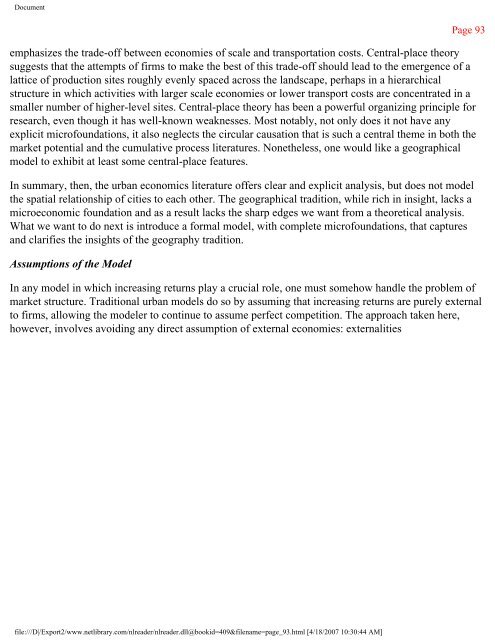Document file:///D|/Export1/www.netlibrary.com/nlreader/nlreader.dll ...
Document file:///D|/Export1/www.netlibrary.com/nlreader/nlreader.dll ...
Document file:///D|/Export1/www.netlibrary.com/nlreader/nlreader.dll ...
You also want an ePaper? Increase the reach of your titles
YUMPU automatically turns print PDFs into web optimized ePapers that Google loves.
<strong>Document</strong><br />
Page 93<br />
emphasizes the trade-off between economies of scale and transportation costs. Central-place theory<br />
suggests that the attempts of firms to make the best of this trade-off should lead to the emergence of a<br />
lattice of production sites roughly evenly spaced across the landscape, perhaps in a hierarchical<br />
structure in which activities with larger scale economies or lower transport costs are concentrated in a<br />
smaller number of higher-level sites. Central-place theory has been a powerful organizing principle for<br />
research, even though it has well-known weaknesses. Most notably, not only does it not have any<br />
explicit microfoundations, it also neglects the circular causation that is such a central theme in both the<br />
market potential and the cumulative process literatures. Nonetheless, one would like a geographical<br />
model to exhibit at least some central-place features.<br />
In summary, then, the urban economics literature offers clear and explicit analysis, but does not model<br />
the spatial relationship of cities to each other. The geographical tradition, while rich in insight, lacks a<br />
microeconomic foundation and as a result lacks the sharp edges we want from a theoretical analysis.<br />
What we want to do next is introduce a formal model, with <strong>com</strong>plete microfoundations, that captures<br />
and clarifies the insights of the geography tradition.<br />
Assumptions of the Model<br />
In any model in which increasing returns play a crucial role, one must somehow handle the problem of<br />
market structure. Traditional urban models do so by assuming that increasing returns are purely external<br />
to firms, allowing the modeler to continue to assume perfect <strong>com</strong>petition. The approach taken here,<br />
however, involves avoiding any direct assumption of external economies: externalities<br />
<strong>file</strong>:///<strong>D|</strong>/Export2/<strong>www</strong>.<strong>netlibrary</strong>.<strong>com</strong>/<strong>nlreader</strong>/<strong>nlreader</strong>.<strong>dll</strong>@bookid=409&<strong>file</strong>name=page_93.html [4/18/2007 10:30:44 AM]
















